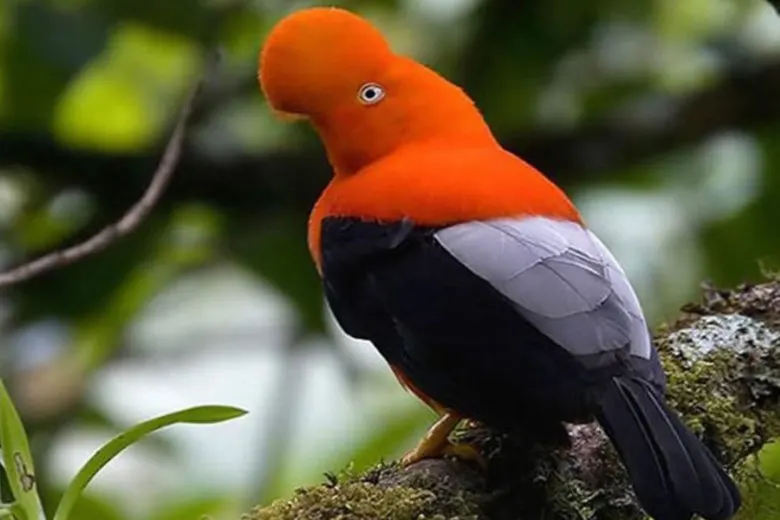The Andean cock-of-the-rock in Manu National Park is one of the most fascinating and colorful birds of the Peruvian rainforest. This species, scientifically known as Rupicola peruvianus, is recognized not only for its vibrant orange plumage but also for its unique courtship behavior. It is so special that it has been designated as the national bird of Peru.
For those passionate about bird photography in Manu, observing this species in the wild is a one-of-a-kind experience. Every year, tourists from around the world visit Manu National Park to enjoy a nature-filled adventure and capture this bird in its natural habitat. Below, we’ll tell you everything you need to know about the Andean cock-of-the-rock, its habits, ecological importance, and how to organize a birdwatching tour in Manu.

Characteristics and Appearance of the Andean Cock-of-the-rock in Manu National Park
The Andean cock-of-the-rock in Manu National Park is easily recognized by its intense reddish-orange plumage and its semicircular fan-like crest. This bird measures approximately 30 to 35 cm, and its compact body is designed to move quickly through the cloud forest trees.
It inhabits cloud forest edges, especially near gullies and ravines close to water sources. Manu National Park, located between the Cusco and Madre de Dios regions, is one of the best places in the world to see it, as it is protected within one of the planet’s most biodiverse natural areas: the Manu Biosphere Reserve.
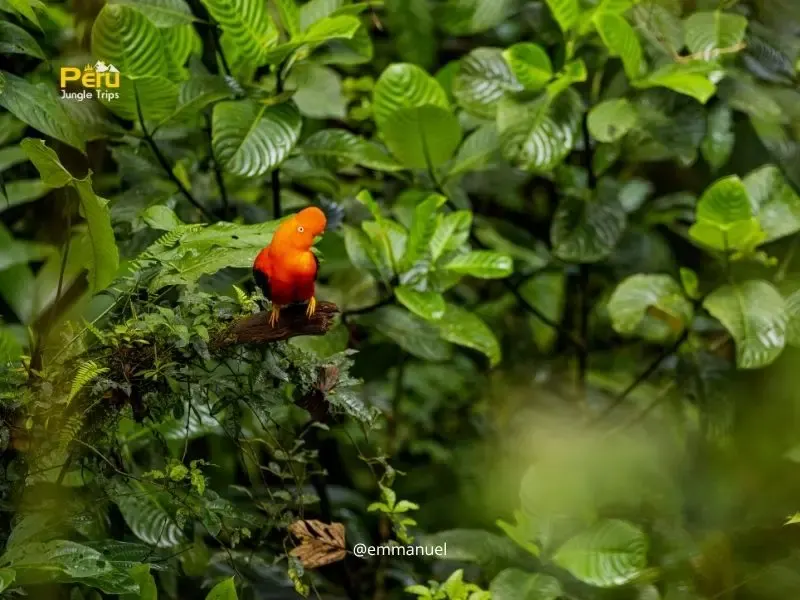
Differences Between Male and Female Cock-of-the-rock
The sexual dimorphism in this species is very pronounced. The male displays a bright orange color, with black wings and tail, yellow eyes, and a large crest. Its flashy appearance serves a clear purpose: to attract females during courtship.
In contrast, the female has dark brown plumage with a much smaller crest. This difference is not coincidental: her camouflage protects her while nesting and caring for the chicks. In summary, the male is showy and loud, while the female is discreet and protective.
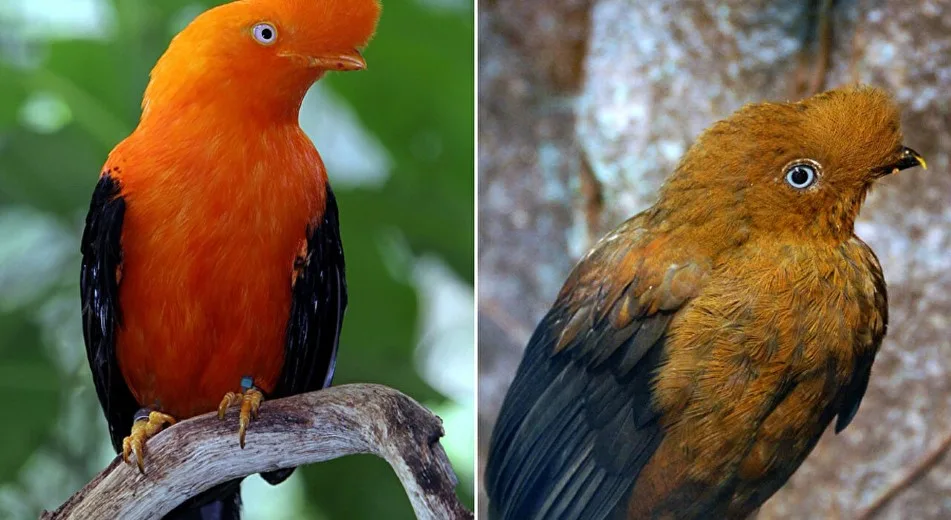
Fun Facts About the Cock-of-the-rock
- It is the national bird of Peru and a symbol of the country’s biodiversity.
- In Quechua, it is called tunki.
- Its call is guttural and screechy, not melodic.
- It primarily eats wild fruits, making it an important seed disperser.
- It is a frugivorous and territorial species.
- It lives in montane forest areas between 500 and 2,400 meters in elevation.
- While it is not endangered, it faces threats from habitat loss and the illegal bird trade.
Courtship Behavior of the Cock-of-the-rock: Lek Dynamics
One of the most impressive behaviors of the cock-of-the-rock in Manu National Park takes place during the breeding season. Males gather in specific spots in the forest called leks, also known as courtship arenas, where they compete to attract females.
Each male takes position on a branch or rock and performs dance displays, with quick movements and jumps, accompanied by loud calls. His goal is to be the most attractive and get chosen by a female.
These shows typically occur at dawn or dusk, and witnessing them is one of the most intense ecotourism experiences in Manu National Park. Females watch from nearby branches and select the most energetic and colorful male. Then, they go off to build their nests alone, usually on a damp rock wall.
This lekking behavior is vital for the species and one of the main reasons birdwatchers travel from afar to see them in action.
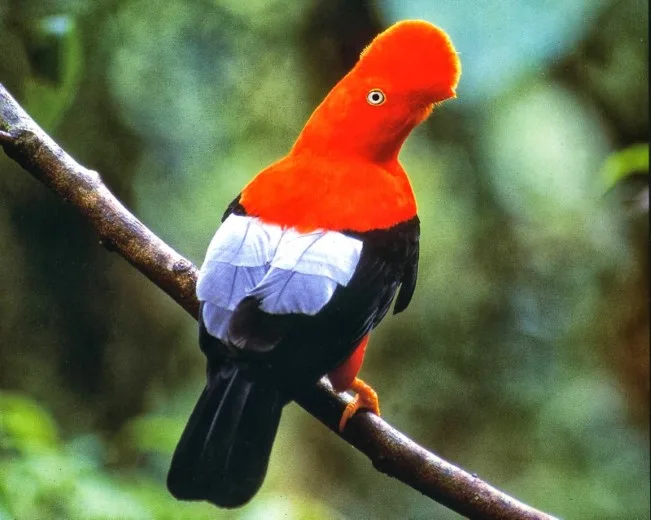
Travel Tips for Spotting the Cock-of-the-rock in Manu National Park
If you’re planning a cock-of-the-rock photography tour, these tips will help you get the most out of your adventure:
- Best season: The best months to observe the cock-of-the-rock are from May to September, during the dry season. There’s less rain, trails are more accessible, and wildlife is more active.
- Recommended times: The best chance to see the cock-of-the-rock is at dawn or late afternoon, during the lek displays.
- Strategic locations: One of the most visited spots is the San Pedro viewpoint, on the road between Cusco and Manu. Several males can be seen there performing courtship rituals. There are also active leks deeper in the forest.
- Recommended gear: Bring binoculars, a camera with a telephoto lens, dark clothing, a rain jacket, hat, insect repellent, and a light backpack. To capture good photos, photographing the cock-of-the-rock requires patience and a good vantage point.
- Hire a specialized agency: For a safe and well-organized experience, it’s best to go with a tour operator that specializes in birdwatching. One of the most recommended is Peru Jungle Trips, which offers itineraries specifically designed to observe and photograph the cock-of-the-rock in its natural habitat.
- Respect the environment: When doing nature tourism in the Peruvian Amazon, it’s essential not to disturb the birds. Stay quiet, avoid flash photography, don’t leave trash, and always follow the guide’s instructions.
Frequently Asked Questions About the Cock-of-the-rock in Manu National Park
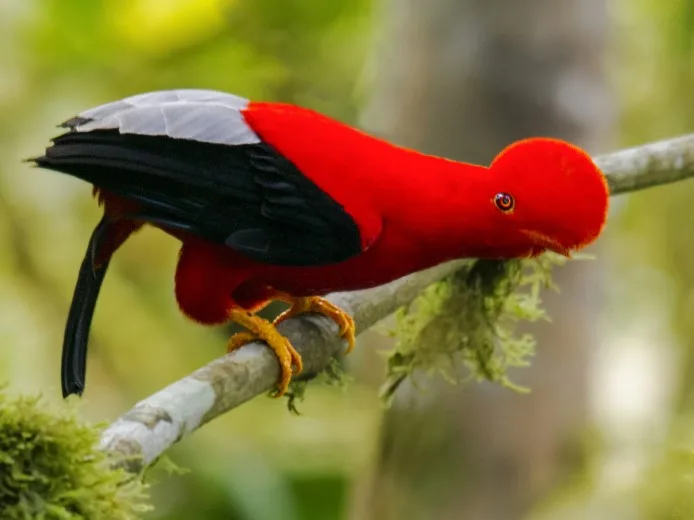
1. What is the Andean cock-of-the-rock and why is it important?
The Andean cock-of-the-rock is a bird species found exclusively in the Andean cloud forests. It is important because it is the national bird of Peru and a key indicator of ecosystem health. It also represents a major draw for ecotourism and birdwatching in Manu National Park. Additionally, its presence reflects the richness and conservation of the Andean habitat. It is one of the most sought-after species by nature photographers.
2. Where can I see the cock-of-the-rock in Peru?
Although it can be found in other high jungle regions, the best place to see the Andean cock-of-the-rock in Peru is Manu National Park, especially in the San Pedro area and other leks within the Manu Biosphere Reserve. These locations offer ideal conditions and easy access for tourists and birdwatchers.
3. What does the cock-of-the-rock’s call sound like?
The cock-of-the-rock’s call is not melodic. It emits loud squawks, clicks, and screeches, very different from the chirping of other birds. These sounds become more intense during courtship, when males compete for the attention of females. This vocalization is an important part of the natural spectacle observed in the leks.
4. Why is it called “cock-of-the-rock”?
It is called this because it nests on rock walls and cliffs, in places that are difficult for predators to reach. Its Latin name, Rupicola, literally means “rock dweller”. This preference for steep, rocky areas offers natural protection, which is crucial for the safety of its nests.
5. What do cock-of-the-rocks eat?
They are frugivores, meaning they feed mainly on wild fruits. By eating and then dispersing seeds throughout the forest, they play a vital role in the regeneration of the ecosystem. This ecological role makes them an essential species for maintaining biodiversity and the health of the Andean tropical forest.
6. Does Manu National Park endanger the cock-of-the-rock?
Deforestation and illegal trafficking threaten it, although it is not critically endangered. The protection of areas like Manu is vital for its long-term survival. While its populations within the park are stable, its status could quickly change without effective conservation.
7. Is it easy to see the cock-of-the-rock?
Not always. It is a very elusive bird. That’s why specialized guides, like those from Peru Jungle Trips, highly recommend having their help to maximize your chances of seeing one. With the right guidance, you can visit leks early in the morning, when the birds are most active and visible.
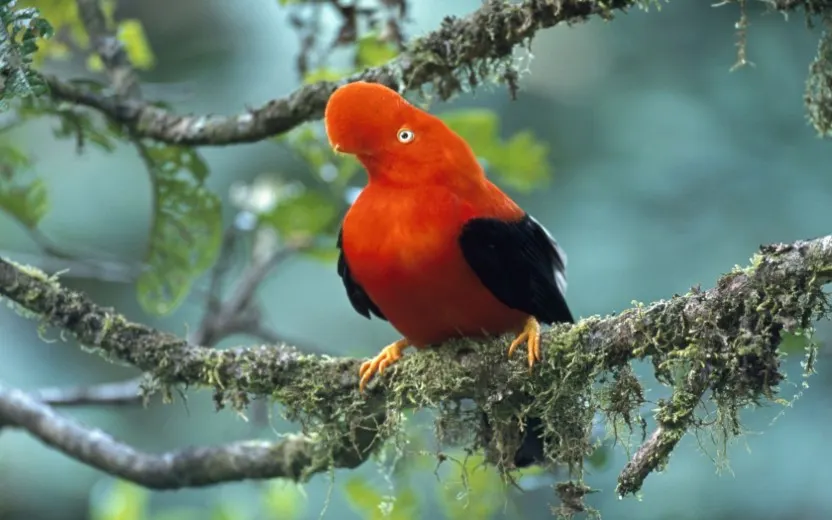
The Andean cock-of-the-rock in Manu National Park is not just a jewel of Peruvian nature. It is also a symbol of the incredible biological richness that Peru offers to the world. Seeing it in the wild, dancing in the misty treetops or perched on a forest rock, is an unforgettable experience. Every nature lover should witness it at least once in their lifetime. Whether for its fascinating behavior, spectacular appearance, or its ecological role, the cock-of-the-rock deserves admiration and protection. If you’re thinking about a journey rich in nature, photography, and culture, consider planning a photo trip to Manu National Park. You won’t regret it. Contact us and book your Andean cock-of-the-rock photo tour in Manu National Park.
Travel Tours to Manu National Park That May Interest You
- Manu National Park Tour (3 Days)
- Manu Jungle Tour (4 Days)
- Manu National Reserve (5 Days)
- Manu Reserved Zone (6 Days)
- Manu Amazon Rainforest Expeditions (7 Days)

